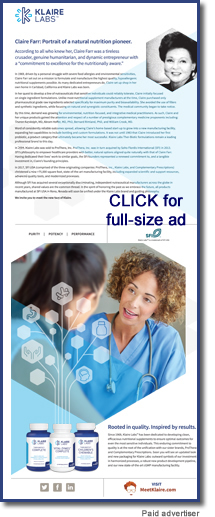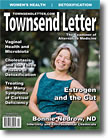|
Unusual polycystic ovarian syndrome (PCOS) presentations make recognition and management challenging. This article will walk through two variants, one highlighted in the literature and the other through clinical practice. The first variant is newly discussed in the literature: a low-androgen, lean, PCOS-type. The second is often misunderstood as being a post-pill syndrome, but rather is a PCOS-induced amenorrhea discovered post-contraceptive discontinuation. Details of both are discussed herein. Since PCOS is the most common endocrine disorder of reproductive-aged women worldwide and one of the top contributors to ovarian factor infertility,1 this article serves as a tool to increase natural pregnancy and live birth rates through better recognition and treatment of these variants.
 Townsend Letter provides a platform for those examining and reporting on functional and integrative medicine. Please support these independent voices. Townsend Letter provides a platform for those examining and reporting on functional and integrative medicine. Please support these independent voices. |
The Society for Reproductive Endocrinology and Infertility (SREI) states that 5-10% of women worldwide have PCOS.2 Women are at especially high risk if they have a history of oligoovulatory infertility; obesity and/or insulin resistance; diabetes type 1, 2, or gestational; premature adrenarche (stage of puberty when the adrenal cortex begins to secrete androgens, typically signified by pubic and axillary hair growth); any first-degree relatives with PCOS; or use of antiepileptic drugs.
As we know, the PCOS diagnosis is typically made by Rotterdam criteria, when an individual has two of the three characteristics:
• Chronic anovulation,
• Hyperandrogenism (clinical or biological), and/or
• Polycystic ovarian morphology (PCOM).3
This criterion is endorsed by the American Association of Clinical Endocrinologists (AACE), the American College of Endocrinology (ACE), and the Androgen Excess and PCOS Society (AES).
There is an exception to the Rotterdam criteria, as recently discussed in the literature. A study published in the Journal of Steroid Biochemistry & Molecular Biology identified a previously unknown lean, PCOS-like phenotype characterized by the following:
• High anti-Müllerian hormone ≥ 75th quartile for respective age,
• Atypically low-testosterone (<19.0 ng/dL),
• Low DHEAS,
• Low cortisol, and
• Predisposition toward autoimmunity; with likely an adrenal autoimmune etiology.4
Based on findings, this subgroup appears more phenotypically PCOS-normal at a younger age, then later shifts from hyperandrogenic (non-obese) to still high AMH, but low-testosterone (non-obese) with advancing age.
Anti-Müllerian hormone (AMH) is a substance produced and released by the granulosa cells of small ovarian follicles and is a biomarker used to measure ovarian reserve.5 AMH can decrease with age, history of chemotherapy and radiation, obesity, and oophorectomy. AMH can increase when there is a higher than average number of small ovarian follicles, such as is the case for some women with PCOS. Adding AMH to a fertility panel is not only an effective way to evaluate ovarian reserve, but can add clues about the presence of polycystic ovarian morphology (PCOM) in the absence of ultrasound, especially if AMH is ≥ 75th quartile for the patient's respective age.
 Total testosterone (T) is typically measured in women suspected to have PCOS, especially with clinical evidence of hyperandrogenism (hirsutism, acne, and/or male-pattern hair loss).6 Measured by liquid chromatography-tandem mass spectroscopy (LC-MS/MS), upper end of normal range is 45 to 60 ng/dL. In women, testosterone can be produced both by adrenals and ovaries; and thus, low-T (<19.0 ng/dL) cannot definitively be due to the dysfunction of either unless there is a concomitant abnormal biomarker to differentiate between the two.4 In this study, the women with high-AMH and low-T also consistently had low dehydroepiandrosterone sulfate (DHEAS) and low cortisol, suggesting an adrenal cause. The authors further propose that there is a potential autoimmune link. When immune and inflammatory markers were examined, anti-TPO antibodies were significantly correlated. Although non-significant, the inflammatory markers, C-reactive protein (CRP, mg/L) and interleukin-6 (IL-6, ng/mL), were twice as high in the identified PCOS-variant subgroup. Total testosterone (T) is typically measured in women suspected to have PCOS, especially with clinical evidence of hyperandrogenism (hirsutism, acne, and/or male-pattern hair loss).6 Measured by liquid chromatography-tandem mass spectroscopy (LC-MS/MS), upper end of normal range is 45 to 60 ng/dL. In women, testosterone can be produced both by adrenals and ovaries; and thus, low-T (<19.0 ng/dL) cannot definitively be due to the dysfunction of either unless there is a concomitant abnormal biomarker to differentiate between the two.4 In this study, the women with high-AMH and low-T also consistently had low dehydroepiandrosterone sulfate (DHEAS) and low cortisol, suggesting an adrenal cause. The authors further propose that there is a potential autoimmune link. When immune and inflammatory markers were examined, anti-TPO antibodies were significantly correlated. Although non-significant, the inflammatory markers, C-reactive protein (CRP, mg/L) and interleukin-6 (IL-6, ng/mL), were twice as high in the identified PCOS-variant subgroup.
In the same study, all participants with high-AMH and low-T were given DHEA, 25 mg tid for at least 6-8 weeks, until their total T levels reached 30 ng/dL.4 They concomitantly were given CoQ10, 333 mg tid, until positive pregnancy test. It was found that. once T levels normalized, they had significantly higher oocyte count, embryo quality, and live birth rates. Those with T levels greater than >30 ng/dL, comparatively, did not have as favorable outcomes.
This study offers a unique treatment approach for someone who presents with the above outlined characteristics who may otherwise 1) go undiagnosed, or 2) not receive support in the way of natural medicine and/or be forced into assisted reproductive technologies (ART) prematurely.
Another PCOS variant worthy of discussion is highlighted in the case of post-contraceptive amenorrhea. This clinical presentation is discussed within the context of this article because of the importance of timely recognition and treatment, and high likelihood for being easily misdiagnosed.
Amenorrhea, or the absence of menses, and anovulation, the absence of ovulation, are not always synonymous. As one of the Rotterdam diagnostic criteria for PCOS, chronic anovulation can present in multiple ways.7 Commonly, chronic anovulation presents when the cycle length is >35 days long, beyond the two-to-three-year period post menarche. However, chronic anovulation can also occur when cycles are of normal length (25-32 days). In fact, hyperandrogenic women with normal length cycles are anovulatory 10-15% of the time. On the other end of the spectrum, women with amenorrhea are also commonly anovulatory. If women have experienced three-months or more of amenorrhea after menarche, they are given the diagnosis of secondary amenorrhea. PCOS is one of many possible underlying etiologies of secondary amenorrhea.
The literature states that amenorrhea occurs at the same frequency post-pill discontinuation as it does spontaneously8; however, women are often very stressed when their menses do not immediately resume post discontinuation. This is especially apparent in women who are actively trying to conceive.
It is important to follow a thorough evaluation and workup of secondary amenorrhea if a woman hasn't had menses for ≥ 3 months after initial menarche, regardless of prior pill use. Serum hCG is necessary to rule out any pregnancy at onset, followed by thyroid stimulating hormone (TSH), prolactin (PRL), follicle stimulating hormone (FSH), and estradiol (E2).9 FSH and E2 may be tested at any time in those with amenorrhea since no information is available about days of the cycle. If TSH, PRL, FSH, and E2 are normal and there is evidence of hyperandrogenism, then PCOS is most likely the cause of amenorrhea. As evidenced by the first PCOS variant discussed in this article, even if hyperandrogenism is not present, you might still consider PCOS a potential cause.4 This would be especially true if you concomitantly find high-AMH (≥ 75th quartile for respective age), atypically low-testosterone (<19.0 ng/dL), low DHEAS, and low cortisol.
Once you identify someone as having PCOS as the underlying cause of their amenorrhea, you can further identify if they fall into the insulin-resistant and/or obese category. This will help determine what treatment(s) may be effective to restore menses and ovulation. There are many lifestyle, diet, and natural medicine treatments to consider, depending upon PCOS subtype. In my recently published article in Townsend Letter, "Evidence Based Botanicals for the Treatment of PCOS & Fertility" (January 2018; p.93-94), recent literature on botanicals used for PCOS is reviewed. In the case of insulin-resistance and obesity, diet and exercise targeting weight loss is a first line approach.10 Metformin may be used to restore cycles in women with insulin-resistant PCOS; however, many women prefer a natural medicine approach prior to trying to conceive. A commonly preferred natural medicine insulin-sensitizing agent for women with PCOS and infertility is myo-inositol. The studied dosage of 4 g/day, along with lifestyle recommendations, can be very helpful for restoration of menses and ovulation.11 It is important not to forget to counsel women that restoration of ovulation can occur prior to resuming menstruation. Women may conceive while treating their PCOS-induced amenorrhea and not accurately identify their pregnancy symptoms.
References .pdf
Dr. Corina Dunlap graduated with a Doctorate in Naturopathic Medicine and Master of Science in Integrative Medicine Research from the National University of Natural Medicine (NUNM). Dr. Dunlap sees patients privately at A Woman's Time and is also research and adjunct faculty at the School of Research & Graduate Studies at Helfgott Research Institute and NUNM. She teaches courses such as: Gynecology & Infertility; Women's Health Research: Fertility and Beyond; Medical Anthropology; and Women's Health Journal Club. Before NUNM, she received her B.A. from Smith College with an emphasis in medical anthropology and international relations.
|
![]()
![]()
![]()
![]()







